Foreword / YouTube Video Review
The review on this website is a brief overview and summary of the objective performance of this speaker. It is not intended to be a deep dive. Moreso, this is information for those who prefer “just the facts” and prefer to have the data without the filler. Discussion about the data and my subjective thoughts can be found in my video below.
For a primer on what the data means, please watch my series of videos where I provide in-depth discussion and examples of how to read the graphics presented hereon.
Information and Photos
The DIY Sound Group HTM-12v2 is a DIY design from Matt Grant which was/is available in kit form from DIYSG.
Note the distinction of this model is “v2” as this is an update that was made from the previous version in 2020. The speaker is ported (front) and the crossover point between the Celestion CDX1-1742 compression driver and the (Eminence made) Denovo 12" Hyperlite™ woofer is specified as 1250Hz. Assembled weight is approximately 36 pounds according to the designer.
Here is a quote from the designer:
The new HTM-12 is the most capable of the current HT(M) lineup and suitable for use in very large home theaters. Even though it’s the largest and most powerful of the HT’s it does so without compromising sound quality. It uses a new Celestion compression driver with a polyimide diaphragm providing smooth yet detailed high frequencies, and the 1.75" voice coil handles extreme dynamics and high output levels with ease. The new 12" Hyperlite™ woofer is the end result of a 1.5 year joint project with Eminence. The Hyperlite features a completely new surround and spider giving the woofer more X-max and lower bass output. Completely frame and cone give a stealth look with no reflections while watching a movie. The Hyperlite™ woofer specs along with its high powered neodymium magnet give this speaker a very well balanced and detailed sound over the bass, mid-bass, and midrange. The large SEOS-15 waveguide has excellent directivity control for a very wide “sweet spot” so everyone hears the same thing without any significant changes in sound no matter where they sit in the room.
A kit for a single speaker (including everything sans enclosure; except for front baffle) was approximately $330.
These speakers were loaned to me by their owner, who built them from the kit. There are no physical or electro-mechanical issues and this unit is a good sample, representative of what one would ideally build from the kit.
CTA-2034 (SPINORAMA) and Accompanying Data
All data collected using Klippel’s Near-Field Scanner. The Near-Field-Scanner 3D (NFS) offers a fully automated acoustic measurement of direct sound radiated from the source under test. The radiated sound is determined in any desired distance and angle in the 3D space outside the scanning surface. Directivity, sound power, SPL response and many more key figures are obtained for any kind of loudspeaker and audio system in near field applications (e.g. studio monitors, mobile devices) as well as far field applications (e.g. professional audio systems). Utilizing a minimum of measurement points, a comprehensive data set is generated containing the loudspeaker’s high resolution, free field sound radiation in the near and far field. For a detailed explanation of how the NFS works and the science behind it, please watch the below discussion with designer Christian Bellmann:
The reference plane in this test is just below the tweeter, per the designer, Matt.
Measurements are provided in a format in accordance with the Standard Method of Measurement for In-Home Loudspeakers (ANSI/CTA-2034-A R-2020). For more information, please see this link.
CTA-2034 / SPINORAMA:
The On-axis Frequency Response (0°) is the universal starting point and in many situations, it is a fair representation of the first sound to arrive at a listener’s ears.
The Listening Window is a spatial average of the nine amplitude responses in the ±10º vertical and ±30º horizontal angular range. This encompasses those listeners who sit within a typical home theater audience, as well as those who disregard the normal rules when listening alone.
The Early Reflections curve is an estimate of all single-bounce, first-reflections, in a typical listening room.
Sound Power represents all the sounds arriving at the listening position after any number of reflections from any direction. It is the weighted rms average of all 70 measurements, with individual measurements weighted according to the portion of the spherical surface that they represent.
Sound Power Directivity Index (SPDI): In this standard the SPDI is defined as the difference between the listening window curve and the sound power curve.
Early Reflections Directivity Index (EPDI): is defined as the difference between the listening window curve and the early reflections curve. In small rooms, early reflections figure prominently in what is measured and heard in the room so this curve may provide insights into potential sound quality.
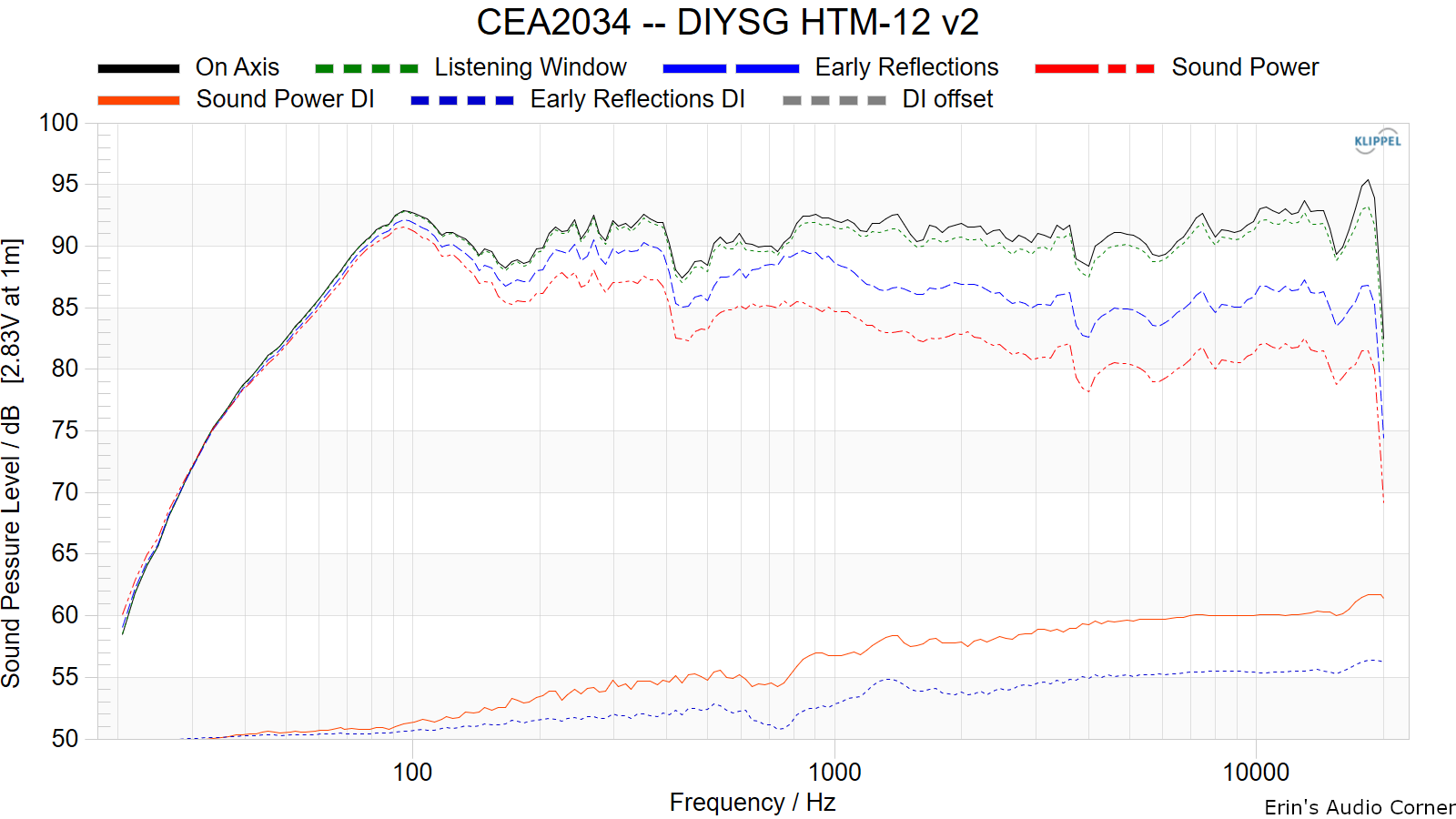
Early Reflections Breakout:
Floor bounce: average of 20º, 30º, 40º down
Ceiling bounce: average of 40º, 50º, 60º up
Front wall bounce: average of 0º, ± 10º, ± 20º, ± 30º horizontal
Side wall bounces: average of ± 40º, ± 50º, ± 60º, ± 70º, ± 80º horizontal
Rear wall bounces: average of 180º, ± 90º horizontal

Estimated In-Room Response:
In theory, with complete 360-degree anechoic data on a loudspeaker and sufficient acoustical and geometrical data on the listening room and its layout it would be possible to estimate with good precision what would be measured by an omnidirectional microphone located in the listening area of that room. By making some simplifying assumptions about the listening space, the data set described above permits a usefully accurate preview of how a given loudspeaker might perform in a typical domestic listening room. Obviously, there are no guarantees because individual rooms can be acoustically aberrant. Sometimes rooms are excessively reflective (“live”) as happens in certain hot, humid climates, with certain styles of interior décor and in under-furnished rooms. Sometimes rooms are excessively “dead” as in other styles of décor and in some custom home theaters where acoustical treatment has been used excessively. This form of post processing is offered only as an estimate of what might happen in a domestic living space with carpet on the floor and a “normal” amount of seating, drapes, and cabinetry.
For these limited circumstances it has been found that a usefully accurate Predicted In-Room (PIR) amplitude response, also known as a “room curve” is obtained by a weighted average consisting of 12 % listening window, 44 % early reflections and 44 % sound power. At very high frequencies errors can creep in because of excessive absorption, microphone directivity, and room geometry. These discrepancies are not considered to be of great importance.

Horizontal Frequency Response (0° to ±90°):

Vertical Frequency Response (0° to ±40°):

Horizontal Contour Plot (not normalized):
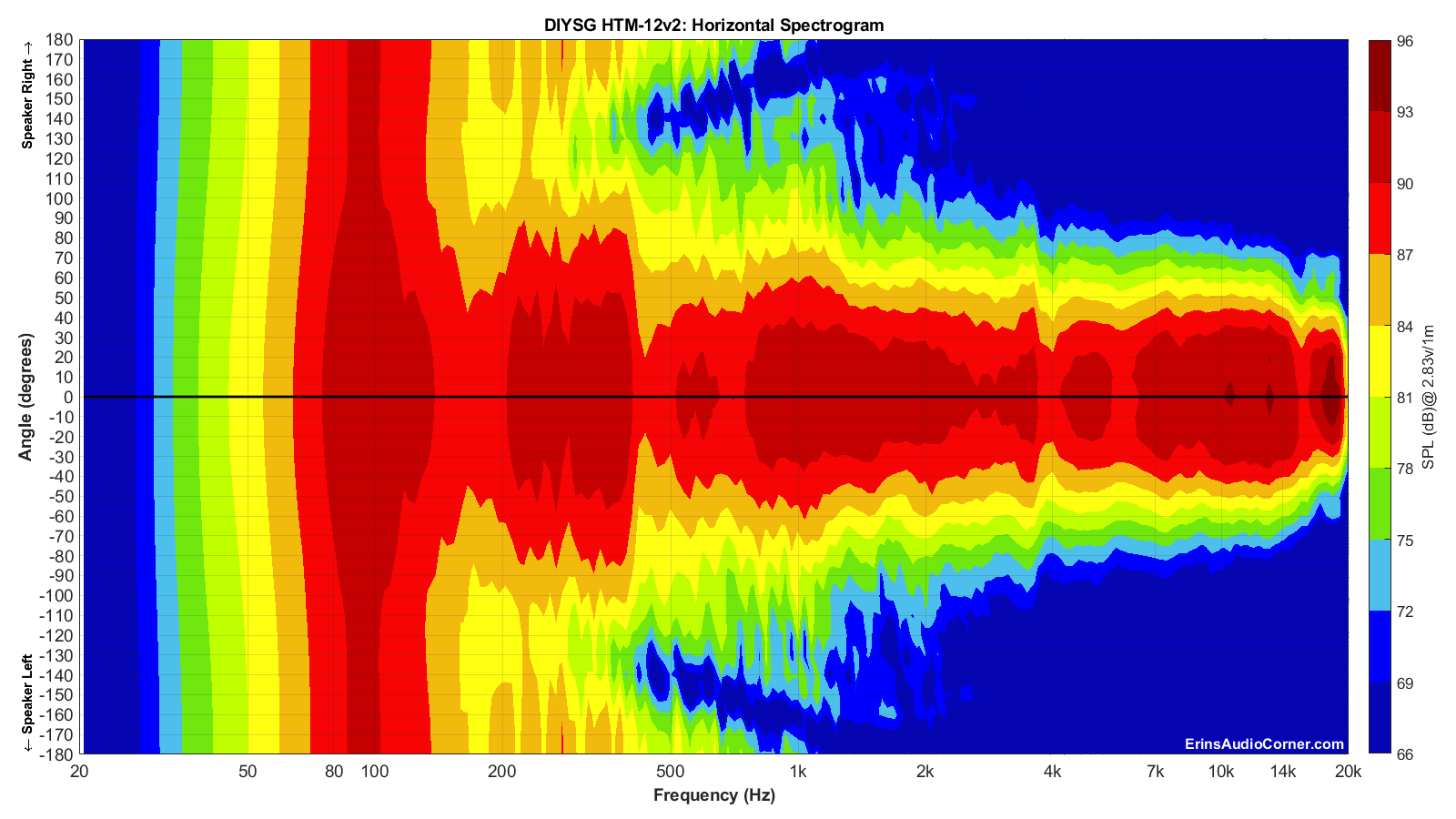
Horizontal Contour Plot (normalized):
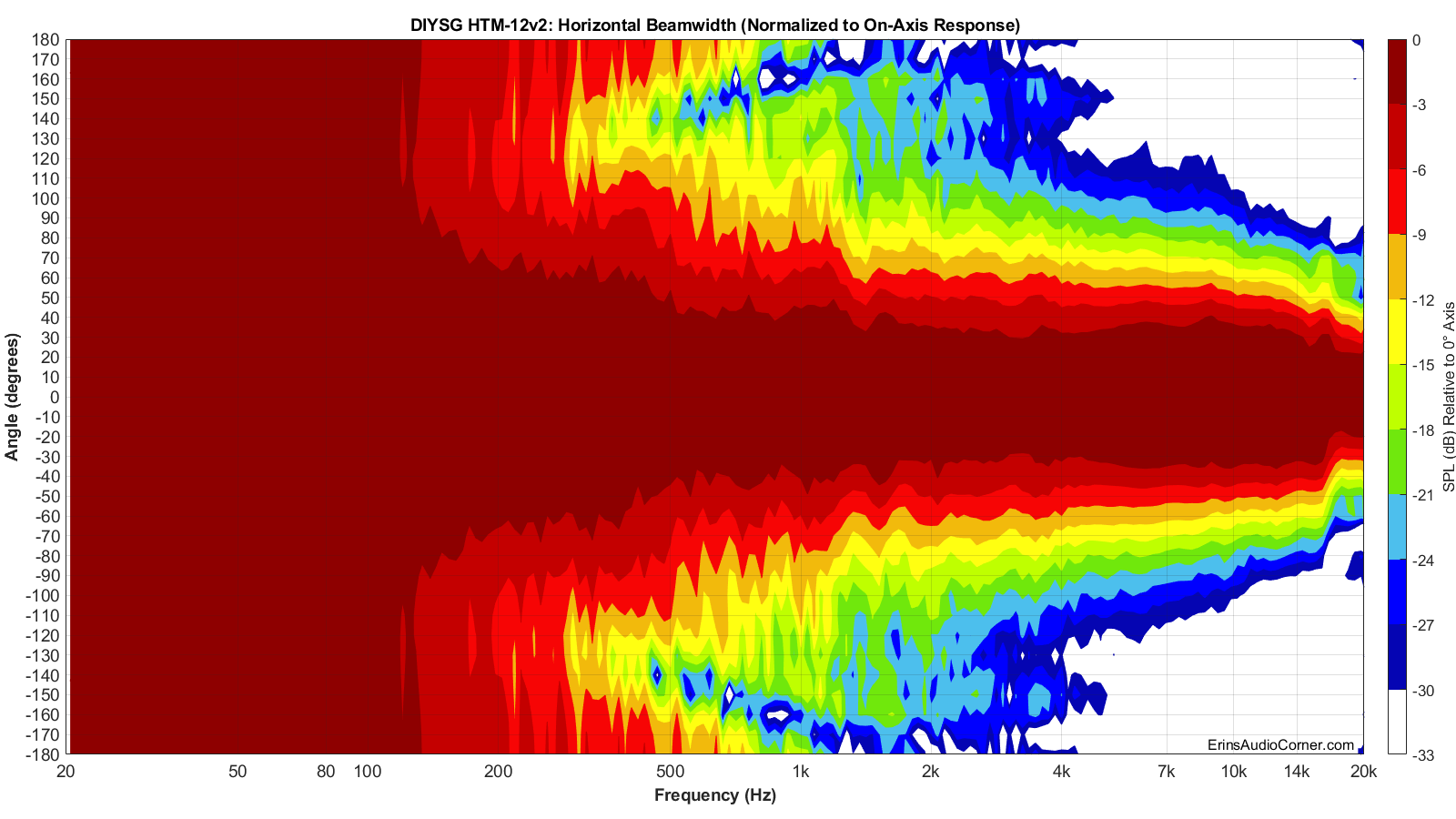
Vertical Contour Plot (not normalized):
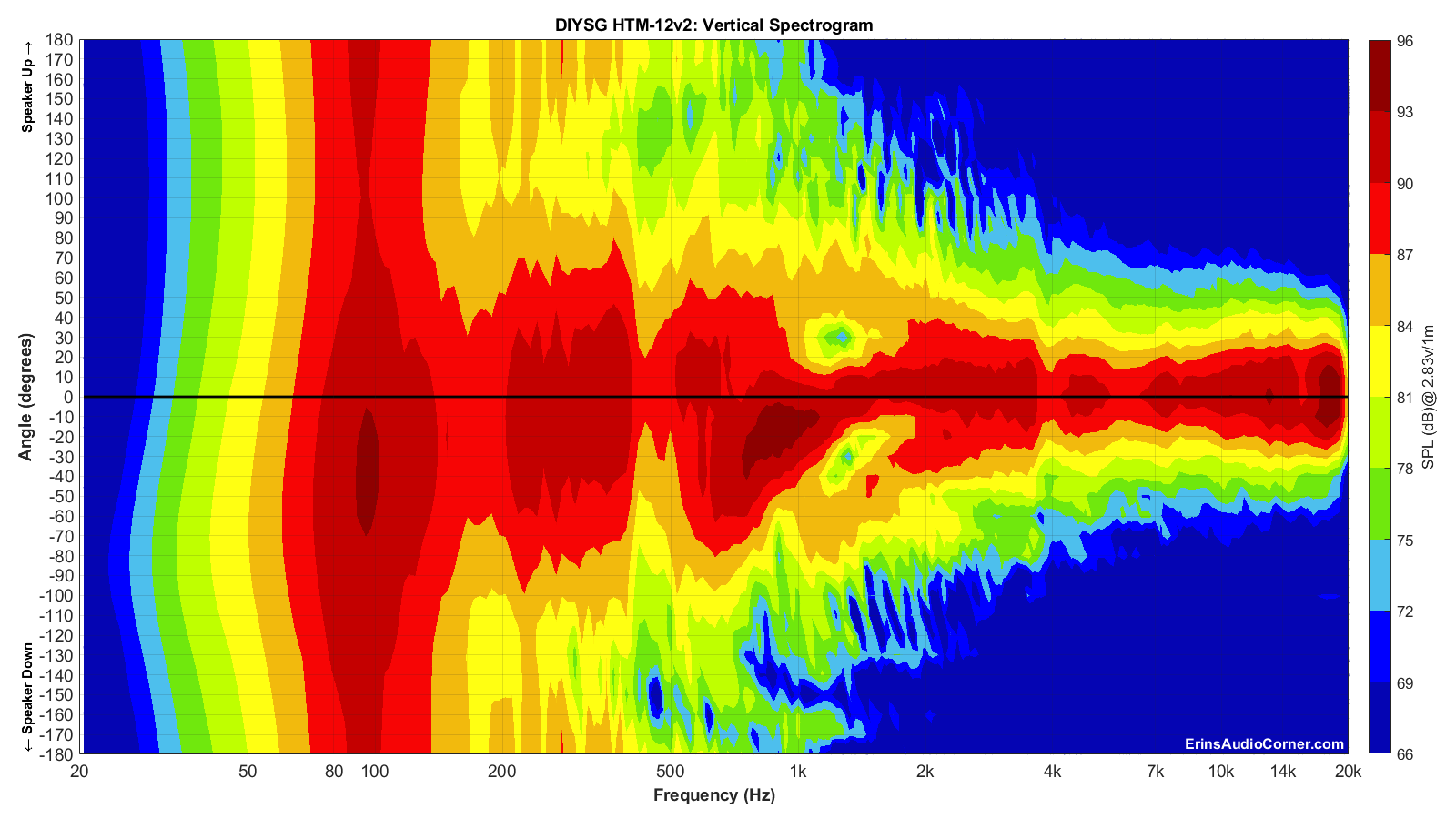
Vertical Contour Plot (normalized):
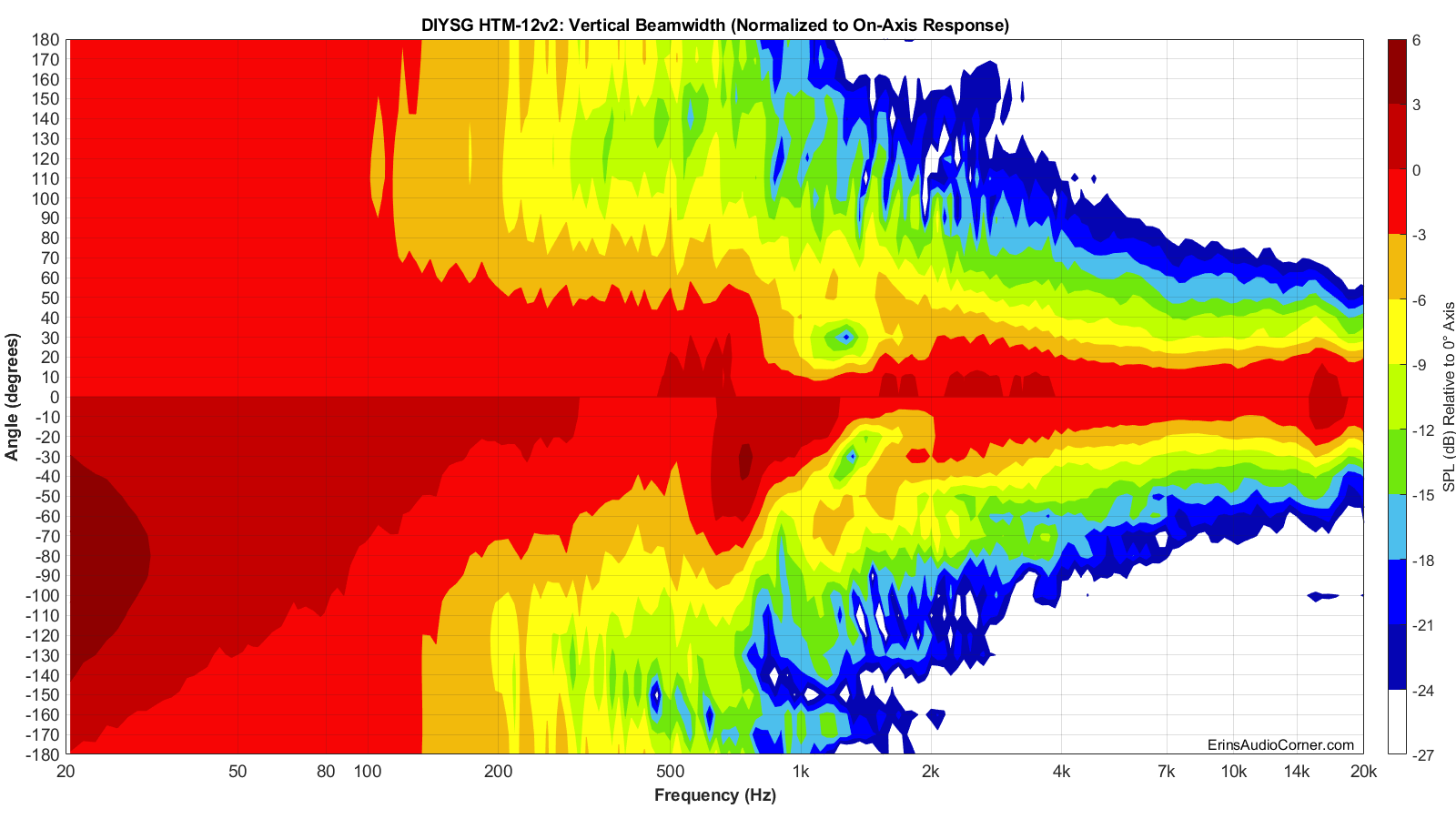
Additional Measurements
Impedance Magnitude and Phase + Equivalent Peak Dissipation Resistance (EPDR)
For those who do not know what EPDR is (ahem, me until 2020), Keith Howard came up with this metric which he defined in a 2007 article for Stereophile as:
… simply the resistive load that would give rise to the same peak device dissipation as the speaker itself.
A note from Dr. Jack Oclee-Brown of Kef (who supplied the formula for calculating EPDR):
Just a note of caution that the EPDR derivation is based on a class-B output stage so it’s valid for typical class-AB amps but certainly not for class-A and probably has only marginal relevance for class-D amps (would love to hear from a class-D expert on this topic).
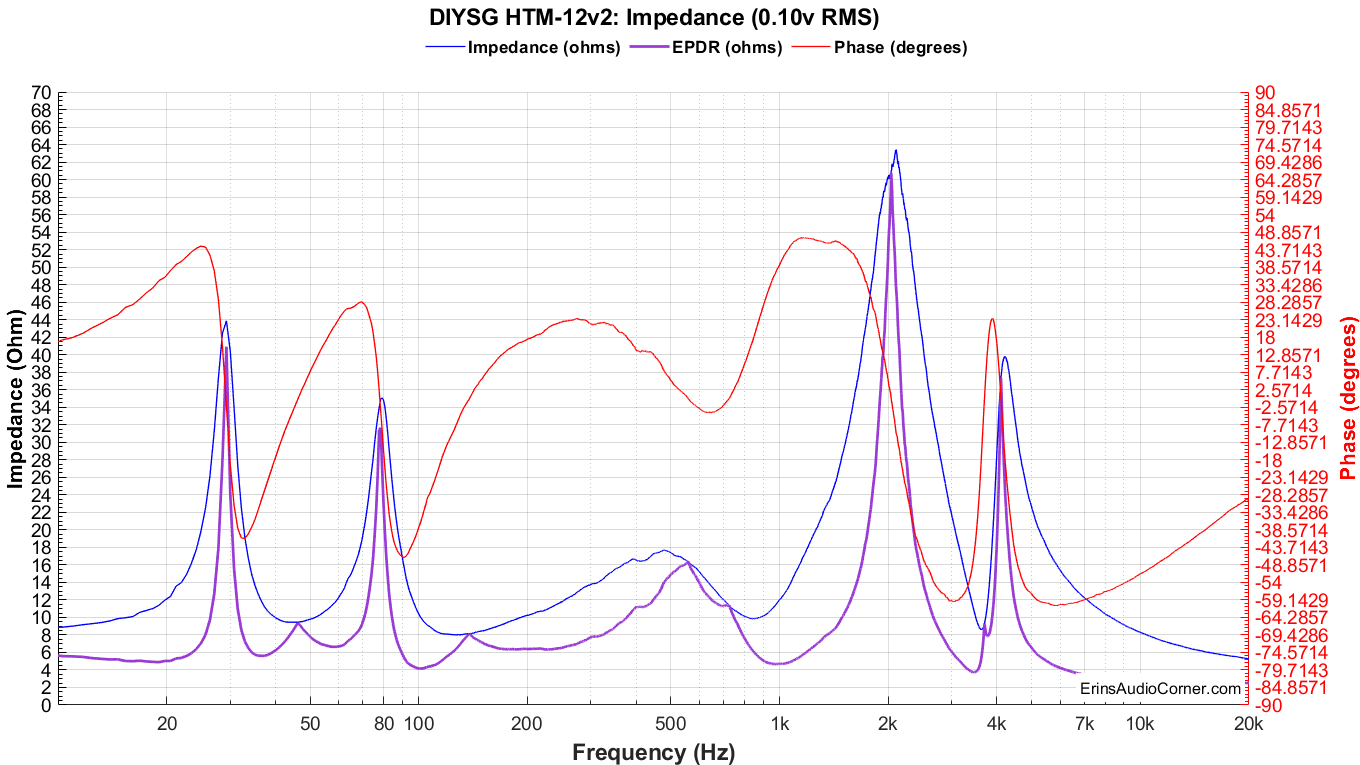
On-Axis Response Linearity

“Globe” Plots
These plots are generated from exporting the Klippel data to text files. I then process that data with my own MATLAB script to provide what you see. These are not part of any software packages and are unique to my tests.
Horizontal Polar (Globe) Plot:
This represents the sound field at 2 meters - above 200Hz - per the legend in the upper left.
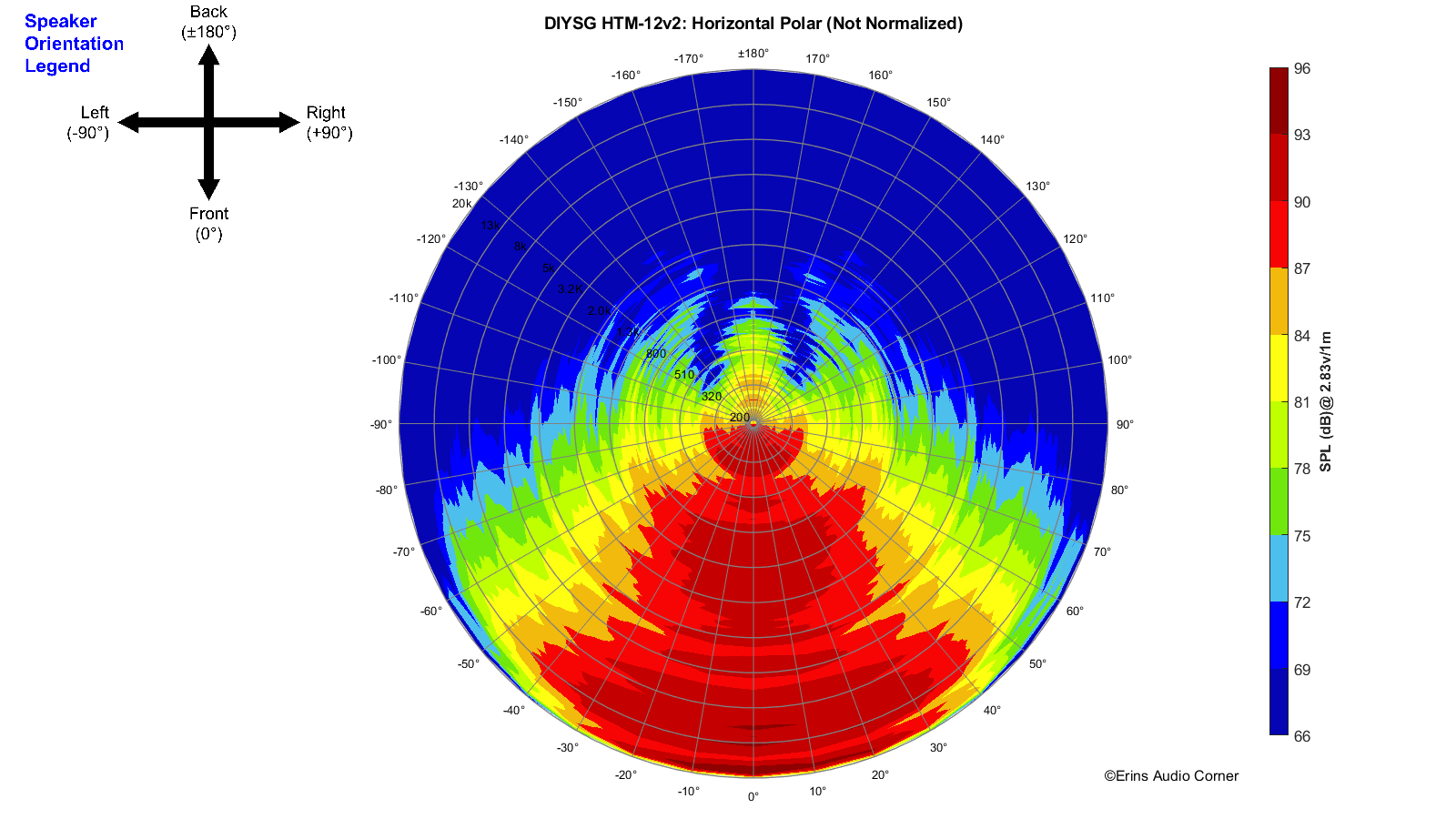
Vertical Polar (Globe) Plot:
This represents the sound field at 2 meters - above 200Hz - per the legend in the upper left.

Harmonic Distortion
Harmonic Distortion at 86dB @ 1m:

Harmonic Distortion at 96dB @ 1m:

Harmonic Distortion at 102dB @ 1m:
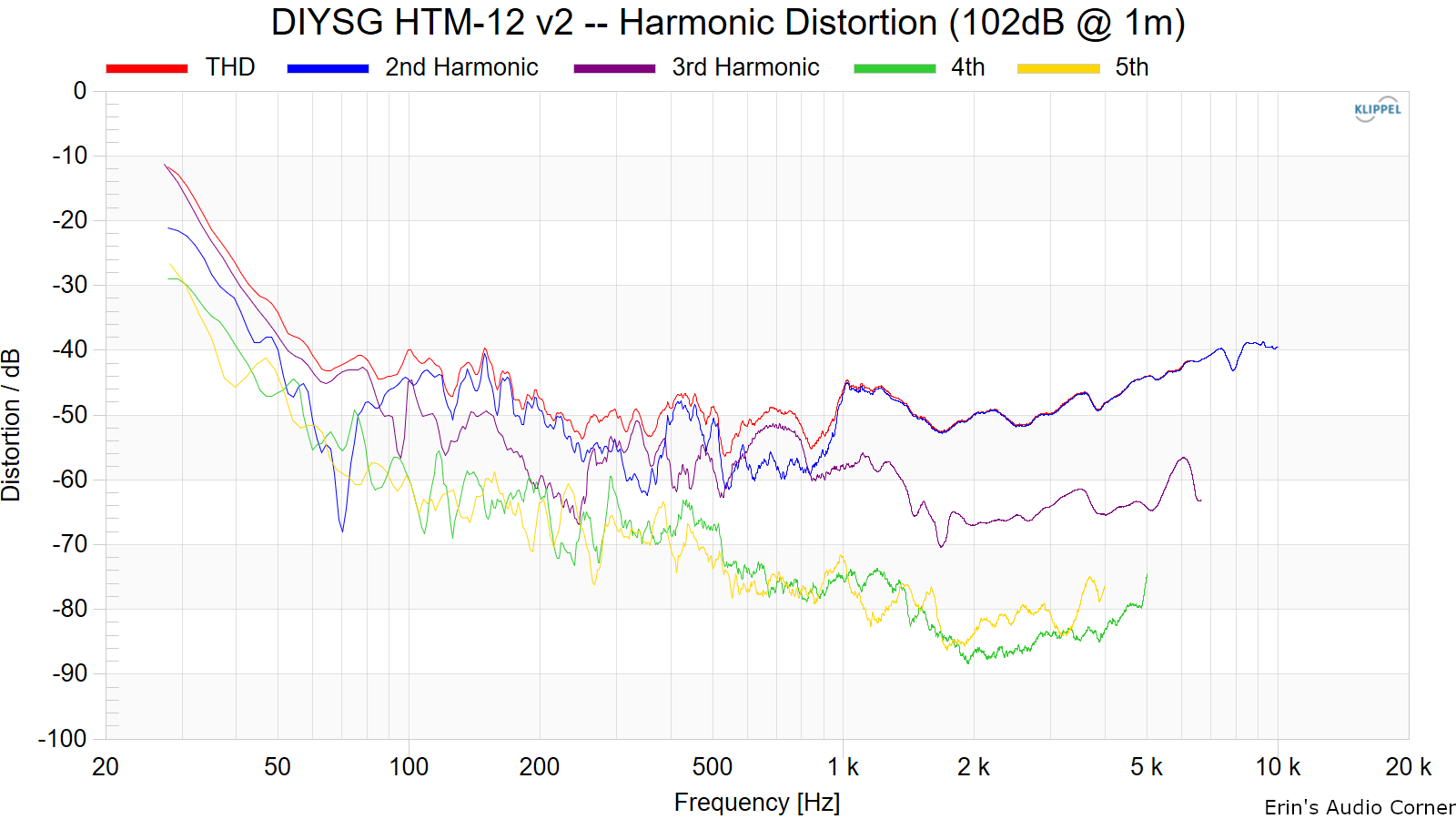
Cumulative Spectral Decay (CSD)

Dynamic Range (Instantaneous Compression Test)
The below graphic indicates just how much SPL is lost (compression) or gained (enhancement; usually due to distortion) when the speaker is played at higher output volumes instantly via a 2.7 second logarithmic sine sweep referenced to 76dB at 1 meter. The signals are played consecutively without any additional stimulus applied. Then normalized against the 76dB result.
The tests are conducted in this fashion:
- 76dB at 1 meter (baseline; black)
- 86dB at 1 meter (red)
- 96dB at 1 meter (blue)
- 102dB at 1 meter (purple)
The purpose of this test is to illustrate how much (if at all) the output changes as a speaker’s components temperature increases (i.e., voice coils, crossover components) instantaneously.

Long Term Compression Tests
The below graphics indicate how much SPL is lost or gained in the long-term as a speaker plays at the same output level for 2 minutes, in intervals. Each graphic represents a different SPL: 86dB and 96dB both at 1 meter.
The purpose of this test is to illustrate how much (if at all) the output changes as a speaker’s components temperature increases (i.e., voice coils, crossover components).
The tests are conducted in this fashion:
- “Cold” logarithmic sine sweep (no stimulus applied beforehand)
- Multitone stimulus played at desired SPL/distance for 2 minutes; intended to represent music signal
- Interim logarithmic sine sweep (no stimulus applied beforehand) (Red in graphic)
- Multitone stimulus played at desired SPL/distance for 2 minutes; intended to represent music signal
- Final logarithmic sine sweep (no stimulus applied beforehand) (Blue in graphic)
The red and blue lines represent changes in the output compared to the initial “cold” test.
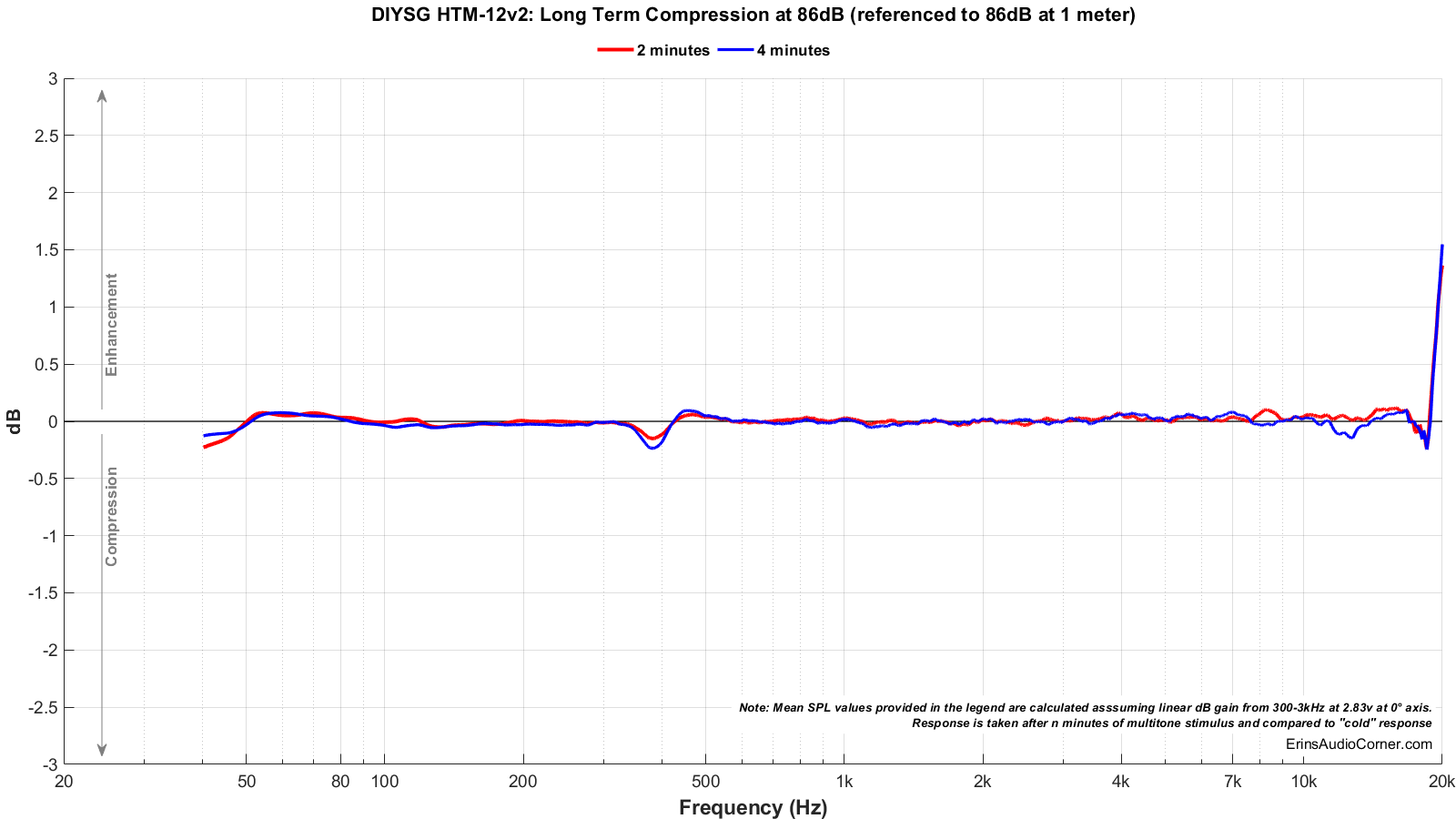
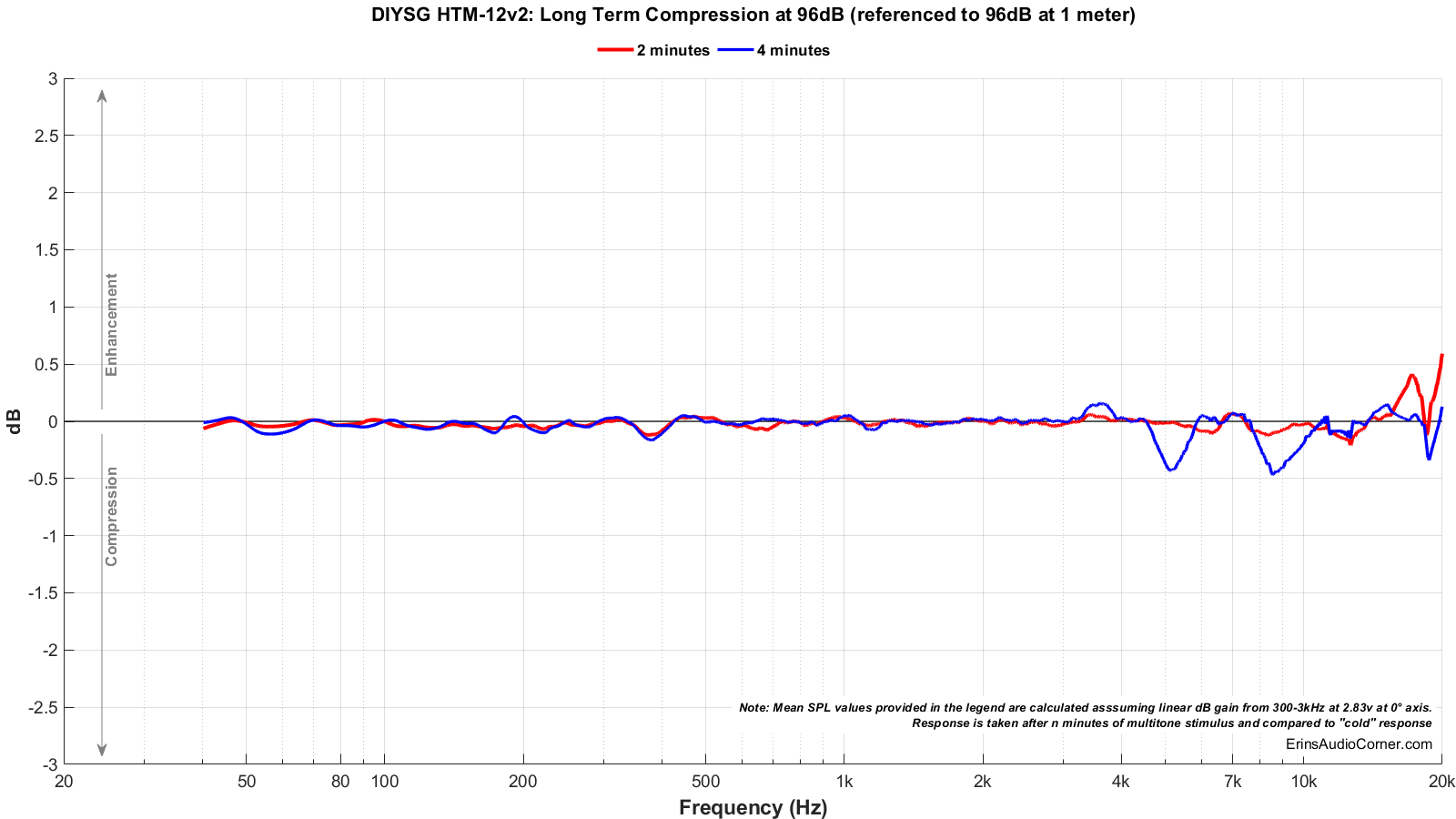
Parting / Random Thoughts
If you want to see the music I use for evaluating speakers subjectively, see my Spotify playlist.
- Subjective listening was mainly in the farfield at 3-4 meters in an open floorplan living room. Subjective listening was conducted at 80-95dB at these distances and occasionally higher. Higher volumes were done simply to test the output capability in case one wants to try to sit further away.
- The sensitivity of this speaker is lower than the v1 version by about 3dB (v1 measured at 94dB @ 2.83v/1m, where the v2 measures at 91dB @ 2.83v/1m). In this case, however, I’d happily take the tradeoff of sensitivity for better frequency response. You’re already in the low 90’s and that’s plenty for most home theater setups. The fidelity is better to have than 3dB sensitivity in this case and in my opinion.
- When listening, I was mostly overall happy with what I heard. The horizontal radiation pattern is fairly narrow (as the data shows) and this tends to keep the speaker from having a very wide soundstage as there is little reflections from the sidewall to help enhance the feeling of spaciousness in the recording. However, some may prefer that (or some rooms may be better served by a speaker like this). The one issue I have - sonically - with these speakers is the amount of lower midrange resonance. This is clearly audible and the CSD data points to the issue being in the ~250Hz region, evidenced by the long settling time of the signal compared to other frequencies. My guess is this is a function of the enclosure height, as the height (25 inches) is equal to a half-wave of about 270Hz. There is another resonance that shows up in the impedance at around 400Hz which seems to also correlate to the width dimension of the enclosure. It is possible additional bracing or simply adding additional acoustic stuffing would remedy these issues.
- The dynamic range (Instantaneous compression) data hints at some potential areas for improvement.
- First, at around 1250Hz the compression peaks at about 0.5dB. We know this is the crossover point. The harmonic distortion data also shows an increase there. Most would look at this and think the crossover is too low. But it is important to realize the level of compression we see; it is roughly 0.50dB at 102dB. Is it worth messing up the excellent directivity at the crossover region in order to relax the compression to a smaller number? I don’t think so. But if one wants to put some more money into things, then maybe. Of course, this could be heating of the actual passive components, though my hunch is we would see that show up in the long-term compression tests and we do not.
- Secondly, there is some funny business going on around 400-500Hz. Looking at the impedance data we can also see some irregularity there evidenced by a “blip”. This indicates a resonance either from the woofer itself or the enclosure. I would have to measure the raw woofer out of the enclosure to know for sure.
- In the low frequency we see compression increase below about 80Hz but from 80-100Hz the compression is pretty much flat. Around 100-200Hz there is some more compression. This leads me to think we are seeing raw driver effects and simply reaching the limits of what this speaker is capable of on the low end. Even though it is a 12-inch woofer, it is on the higher-side of sensitivity and we expect to lose output on the low end compared to a traditional 12-inch woofer.
- The high frequency above about 6kHz tends to widen in directivity which means it could potentially sound a bit bright. I’d consider using some acoustic absorption on the sidewalls that would help absorb some of this but I wouldn’t go too thick. I think - and this is pure speculation - that 1-inch thick acoustic paneling on the first reflection points would make a positive difference here. Though, with that said, some people prefer a little bit of treble. In my own opinion, however, this extra “boost” isn’t ideal.
In my opinion, this is a significant step up from the previous “v1” iteration of this speaker.
While the response is not flat by any means, the directivity control of this speaker is excellent. There are midrange nulls - but in every axis. This means that with a little bit of EQ to straighten out the kinks in the midrange, you end up with a speaker that has a more linear response and does so in every axis, spreading the same energy to the sidewalls as it does directly at the listener making for a more pleasant sound for music and home theater alike.
Even in its raw form (without EQ) I’m quite impressed with what this speaker does. If the designer can figure out what is causing the dips mentioned above and can also fix the resonances I am hearing in the low midrange, I imagine this will be a world-class speaker besting what highly-regarded manufacturers produce at a significantly higher cost to the user. However, it should be noted these issues may increase costs. I just imagine what it is capable of with a little more money put into it either via passive components or even DSP.
This is an obvious “recommend” from me given the target, the performance and the potential to be even better with some DSP.
Support the Cause
If you like what you see here and want to help support the cause you might be interested in joining my Patreon, here. You can also contribute via PayPal (the big yellow button below).
Your support helps me pay for new items to test, hardware, miscellaneous items and costs of the site’s server space and bandwidth. All of which I otherwise pay out of pocket. So, if you can help chip in a few bucks, know that it is very much appreciated.
Alternatively, if you have a need to purchase anything through Amazon, please consider using my Amazon affiliate link below. It yields me a small commission at no additional cost to you and allows me to keep providing you with sweet data to make educated purchase decisions.
You can also join my Facebook and YouTube pages if you would like to follow along with updates.